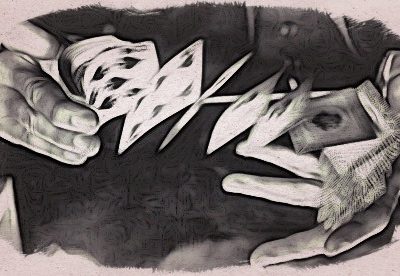DEAL
CHRONICLES OF THE DOKA
#19 in a continuing series—84 days in the teaching life of an American sensei in 1999
Rather than starting my evening class on the hour, I let students intermingle. I cue them up ten minutes after eight. In this brief time I can observe their interplay to better gauge their energy and mood. Watching students tells me a great deal
about them. This is a common practice used by old world Asian monastic
teachers. A student is carefully observed after given a task. The
teacher can then
note the peculiar strengths and weaknesses of his disciples and choose
the
appropriate lesson. I don’t offer cookie cut classes. And I never
prepare a
curriculum before hand because you never know who is going to show up. I’ve become very comfortable teaching this way. It’s more genuine
and in-the-moment.
During
training I also shuffle students through drills like a card dealer might
shuffle a deck of cards. I pair the soft with the hard, the outgoing with the
mellow, the assertive with the aggressive, the timid with the courageous, the
heads with the body’s, the white collars with the blue, the brown belts with the
orange belts etc. Combinations are endless. Unique energies are only activated
when the Jack, for a metaphorical example, is placed next to the Queen, or the Ace is asked to
work with the Ten of Spades. You see, a good martial alchemist must learn to
recognize the different properties and spiritual frequencies of his students to
find the right catalytic mix that causes the most positive change. This is
something of a lost, but critical, dojo teaching art today.

